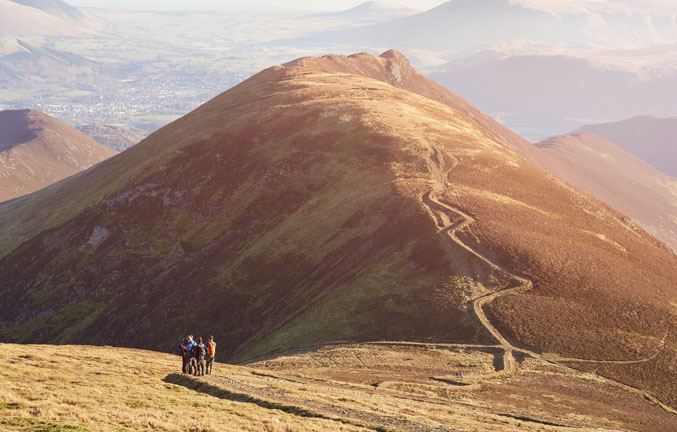E-Newsletter Signup
For special offers, updates and news of new products join our newsletter.
- Also in Blogs
- Sustainable Camping: Preserving Nature for Future Generations
- Embracing the Renewal of Spring: Camping Adventures Await.
- Beating The Winter Blues!
- The History of Cycling
- Senior Camping: Young at Heart
- View all posts in this category >>
GUEST BLOGGER
If you would like to contribute to our blog as a guest and can bring fresh outdoor experiences, please:
Rambling: A Short Walk through its History
Posted in Blogs on 12th October 2022
Walking through the countryside, also known as rambling, first became a popular leisure activity during the 18th century. Today, Britain offers some of the best rambling opportunities in the world, with a number of historic long-distance walking trails spanning the length and breadth of the country.

© Duncan Andison / Shutterstock.com
There are around 500 official ramblers’ groups in the UK, with the Ramblers’ Association boasting more than 107,000 members. Walking has become one of Britain’s most popular outdoor leisure activities, especially since the Countryside and Rights of Way Act 2000 opened access to vast areas of public land.
In Scotland, there has traditionally been universal access to land for generations. This was formally regulated by the Land Reform (Scotland) Act 2003. Only in Northern Ireland are there few rights of way or access to land for ramblers, making it the odd one out of the four home nations.
History of rambling
Walking in the countryside for pleasure was popularised by the priest Thomas West in 1778, when he published his guide to walking in the Lake District. The Scots-born clergyman and author described vividly the beautiful scenery and wildness of the region when he wrote A Guide to the Lakes.
He had already travelled widely throughout Europe when he decided to mark out some routes around Britain too. His book was of particular interest to artists. West wrote in the introduction that he had noted all the “select stations and points of view” where visitors could take a break.
His guide led to more people undertaking a countryside walk for pleasure, as tourists wanted to see in person the beautiful views that they had read about, so that they might appreciate their aesthetic qualities. A big success, it was heralded the modern era of tourism that the Lakes is known for today.
English poet, William Wordsworth, was also instrumental in making rambling more popular. At the age of 20, he set off on a tour of France, Switzerland and Germany in 1790. He recorded his journey in a long autobiographical poem, The Prelude.
In 1798, he went walking around Wales with his sister Dorothy, where he wrote his famous poem, Tintern Abbey, inspired by their visit to the Wye Valley. The following year, his good friend, the poet Samuel Taylor Coleridge, joined Wordsworth for a three-week tour of the Lake District.
Both men were keen walkers and members of the public wished to emulate their travels and try rambling themselves. In 1818, English poet John Keats and his friend Charles Armitage Brown undertook a walking tour of the Lake District, Scotland and Ireland.
More and more people took up rambling throughout the 19th century, including author Robert Louis Stevenson, whose journey across France was famously recorded in his 1879 book, Travels with a Donkey. These guides by authors and poets were the forerunners of the 20th century travel writers.
20th-century ramblers
Rambling continued to be a popular recreational activity in the 20th century, particularly among city dwellers who wanted to get away from it all by taking a rural break. For those escaping the hustle and bustle of urban life (not to mention traffic pollution), destinations such as the Lake District were a haven of health and relaxation.
As the number of walkers grew, however, access to the countryside became more of a challenge, due to the Enclosure movement, comprising private landowners who closed off their land to the public. During the early 20th century, increasing numbers of walking clubs began campaigning for walkers’ rights.
The National Council of Ramblers’ Federations was formed in 1931, when six regional federations of walkers from all over the UK joined forces. The federation spoke on behalf of walkers at the national level.
On 24th April 1932, the landmark Kinder Scout Trespass saw between 400 and 600 ramblers organise a mass protest at the Derbyshire Peak District. Not everyone was in favour of this radical course of action, aimed at raising awareness of access problems.
Protesters met at Bowden Bridge quarry and walked to the plateau of Kinder Scout, where gamekeepers attempted to block their way. Violent scuffles ensued, but the ramblers carried on to their destination at Ashop Head.
Six ramblers were arrested during the protest. Although trespass wasn’t a criminal offence, they received jail sentences of between two and six months relating to violence, as fights broke out with the gamekeepers.
While the federation didn’t actively support the protest, it certainly gave publicity to the campaign for countryside access rights.
Ramblers’ Association
The Ramblers’ Association was officially created on 1st January 1935 to campaign through legal means for walkers’ rights. It became a long and hard-fought battle to improve the access laws that kept much of the British countryside off limits.
In 1949, the landmark National Parks and Access to the Countryside Act was passed. It required footpaths in England and Wales to be recorded on maps to aid walkers. The legislation also laid the foundations for the establishment of National Parks and National Trails in Wales and England. The first National Nature Reserve was created at Beinn Eighe in Scotland in 1951.
The “right to roam” was to elude walkers in England and Wales for another half-century. The Ramblers’ Association launched its Forbidden Britain campaign in 1985, resulting in the Countryside and Rights of Way Act finally permitting public access to moors, mountains, heaths and downland in 2000.
Best rambling destinations
Today, the UK has some excellent walking destinations, such as the Southwest Coastal Path. The National Trail is the longest marked long-distance footpath in England, spanning 630 miles from Minehead in Somerset, along the beautiful coastal areas of Devon and Cornwall, to Poole Harbour in Dorset.
Other popular routes include the Pennine Way, which is a 267-mile path stretching from the Northumberland National Park to the Derbyshire Peak District. Two trails follow the lines of ancient fortifications, including Offa’s Dyke Path, a 176-mile trail that marks the remains of Anglo-Saxon earthwork from the 8th century that once separated the Kingdom of Powys from the Kingdom of Mercia.
The Hadrian’s Wall Walk stretches 84 miles from Bowness-on-Solway to Newcastle-upon-Tyne. The famous fortification once marked the northernmost edge of the Roman Empire.
Benefits of walking
People who go walking regularly will start to experience the associated health benefits, both physical and mental. Helping to keep you physically fit, being outdoors in the fresh air, whatever the weather, is a proven way of helping to alleviate depression.
If you’re interested in rambling with other like-minded people, contact the Ramblers’ Association for details of the 500 local groups to see which are in your area.
The organisation relies on an extensive network of volunteers who help run its local groups. They help maintain paths, continue campaigning for greater access and lead walks at the local level. Contact the association if you’re interested in starting a local group or if you’d like to help run an existing one.



